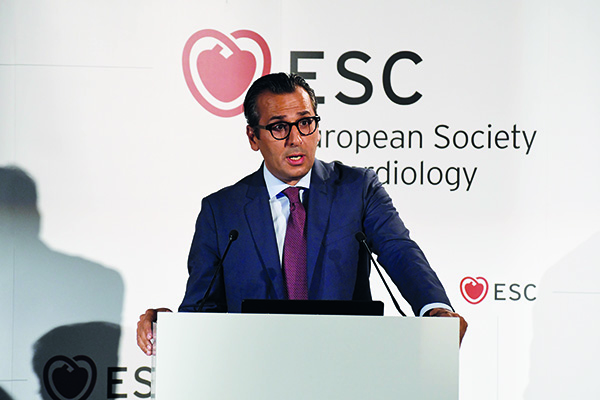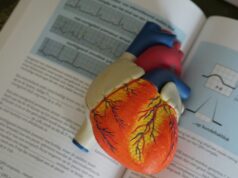
Catheter ablation of atrial fibrillation significantly reduces mortality and hospitalisation in atrial fibrillation patients with heart failure in comparison with conventional treatment, data from the CASTLE-AF trial suggest. Investigators Nassir Marrouche (University of Utah Health Care, Salt Lake City, USA) and colleagues described the findings of CASTLE-AF as “substantial”.
There is a strong connection between atrial fibrillation and heart failure—more than 30% of heart failure patients either have atrial fibrillation or will develop it in the future. These patients have a much worse prognosis with regard to survival and hospitalisation than heart failure patients without atrial fibrillation. Presenting the results of CASTLE-AF at the European Society of Cardiology (ESC) congress (26–30 August, Barcelona, Spain), Nassir Marrouche said that the management of patients with both atrial fibrillation and heart failure was still a “major dilemma”. He commented: “Even the guidelines do not give us straightforward suggestions or recommendations as to how to treat these patients. We have a variety of options because there is no single study that shows a treatment better than others. Nine years ago, we came up with the idea to look at the treatment of atrial fibrillation—ie. catheter ablation—in terms of improving outcomes in this patient population, and we started, based on that, the CASTLE-AF trial.”
CASTLE-AF (Catheter ablation versus standard conventional treatment in patients with left ventricular dysfunction and atrial fibrillation) was an investigator-initiated prospective, multicentre, randomised controlled study. Following screening of more than 3,000 patients, 397 participants with symptomatic paroxysmal or persistent atrial fibrillation were enrolled and randomised to catheter ablation or standard medical therapy.
Marrouche outlined the study design: “After a run-in period of five weeks to optimise the heart failure treatment, we ended up having 179 patients in the catheter ablation group, and 184 in the conventional treatment group, followed for a mean of 37 months up to a maximum of five years. For the first year, patients were followed every three months; after that, every year.”
Exclusions due to patient crossover reduced the number of participants in the catheter ablation group to 153. The primary endpoints of the study were all-cause mortality and worsening heart failure admissions, with a number of secondary endpoints recorded, among which were cerebrovascular accidents, cardiovascular mortality, and unplanned hospitalisations due to a cardiovascular reason.
Marrouche described the endpoints as a “major strength of the study”. He explained: “The first—not only catheter ablation in heart failure trial but also the first catheter ablation—study ever, to report hard primary endpoints. We always looked at quality of life, suppression of atrial fibrillation, changes in ejection fraction, etc. And that is why it took us so long. The study had a longer follow-up, five years.”
The conventional arm was treated according to the ACC/AHA/ESC 2006 guidelines for the treatment of atrial fibrillation in heart failure. Efforts to maintain sinus rhythm were recommended for this group. Anticoagulant therapy was started if it had not already been initiated and continued throughout the study, with the international normalised ratio maintained between 2 and 3.
The catheter ablation arm underwent pulmonary vein isolation, with additional lesions ablated at the discretion of the operator. Following a blanking period, catheter ablation was repeated.
The investigators observed a statistically significant 38% risk reduction with catheter ablation, compared with the conventional group, from baseline at 60 months. Individually, the risk of worsening heart failure admission was reduced by 44% from baseline in the catheter ablation group and all-cause mortality risk was reduced by 47%—both of which were statistically significant in comparison to conventional treatment.
The secondary endpoints of cardiovascular mortality and hospitalisation also revealed statistically significant risk reductions for catheter ablation in comparison to conventional treatment, with cardiovascular mortality risk reduced by 51%, and cardiovascular hospitalisation risk by 28%.
The findings were hailed by Carina Blomstrom-Lundqvist (Uppsala University, Uppsala, Sweden), as “highly relevant”. She said: “CASTLE-AF is novel, because it is the first time we have used as primary endpoints mortality and hospitalisation, and both, combined and separately, showed a reduction of events in the catheter ablation arm compared to conventional treatment. And the follow up was long term.”
However, Blomstrom-Lundqvist pointed out that some factors remained unanswered, including whether less experienced centres would achieve the same results and low complication rates as those in the trial. She also questioned whether there was a bias towards recruiting healthier patients better able to withstand the procedure because only a minority in the study had long standing atrial fibrillation, and what the findings would mean for the treatment of asymptomatic cardiac heart failure patients with atrial fibrillation, as symptomatic atrial fibrillation patients were included in the trial. “That question we do not know how to answer.” In addition, the randomisation of patients before the optimisation period could have led to some bias in the results, she said.
Summing up the trial results, Marrouche said: “Catheter ablation for atrial fibrillation in patients with heart failure led to an improvement in all-cause mortality and led to fewer admissions for worsening heart failure when compared with conventional adopted treatment today. The driver for this seems to be cardiovascular mortality and cardiovascular hospitalisations, which also improved in the catheter ablation arm.”
When asked how heart failure patients with atrial fibrillation should be treated, Marrouche was unequivocal: “Ablate them very soon in the disease stage, before they get to ejection fraction less than 25%, or before they get to heart failure New York Heart Association class IV or class III.”
Blomstrom-Lundqvist concurred, saying that the take-home message was: “It is time to offer catheter ablation procedures at an earlier stage in chronic heart failure patients with atrial fibrillation. But, be careful to select the patients, and that selection should reflect the populations included in the trial.”










Dr. Marrouche is my doctor. He has performed 2 ablations on me, in Jan 2013 for afib and Sept 2017 for A flutter. Both seem to have gone smoothly. Thankfully, I do not have heart disease or other heart problems. I printed out this article for a friend with afib and heart disease and diabetes, and…. Perhaps it will help her Utah cardiologist, and her other doctors.
THANKS Dr. Marrouch for all you have done for me, and others. See you next week. PS: I will share more info about essential oil research and the heart.